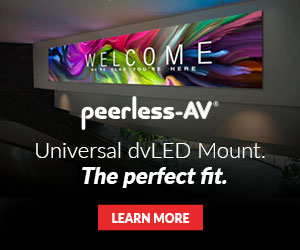
AV-over-IP continues to pick up traction among integrators in the ProAV industry, but there are still quite a few that find themselves questioning if they should start implementing this technology. In fact, 45% of respondents in a 2019 industry survey revealed that they either do not embrace, or are on the fence with adopting AV-over-IP as a viable AV distribution solution – nearly half. So why all the hesitation, and furthermore, why is now the right time for using AV-over-IP?
Let’s start with asking what is AV-over-IP? It stands for Audio-Visual over Internet Protocol, which might sound a little challenging to some AV integrators who don’t know anything about networking.
AV-over-IP (also known as AVoIP) refers to the use of standard network equipment to transmit and switch video and audio. At its foundation the basic AV-over-IP system is quite simple. Sources are being encoded, connecting through a network switch to decoders that are then connected to displays (see image below).

What about more complex AV-over-IP applications in ProAV? Just take a look at the sample below where you see converged usage of Digital Signage, IP Surveillance, Content Servers, Blu-Ray players, Set Top Boxes, and Personal Computers…. all on the same network.

When looking at these examples it may cause some AV dealers to avoid taking on AVoIP due to apprehensions about the technology, networking skills, cost, interoperability, flexibility and scalability. Let’s address some of these concerns head on.
There are numerous products available for AVoIP, which can cause difficulty deciding which technology, networking hardware or brands to use. In contrast with past attempts at accelerating AV over IP, it’s not just one or two obscure vendors that are stepping into this change. The largest and most influential AV vendors in the industry are leading the change. For example, the Software Defined Video over Ethernet (SDVoE) Alliance is an eco-system of companies in and around the AV-over-IP space, working together to create a fantastic platform for the next generation of audiovisual applications. Not only do all SDVoE products and solutions work together, network hardware manufacturers, like NETGEAR, are making it easier than ever to deploy them. SDVoE partners provide the audio-video products while NETGEAR, one of the founding members, provides the backbone network products that make it all possible, with interoperability being key.

What about the networking skill sets and support required for these systems? NETGEAR, for example, not only will provide design engineers (with ProAV experience) to help specify products, but will actually provide an optimal network topology design for you. Their Pro AV Engineering Services team are trained AV and IT professionals to help you both before and after the sale as well as during installation, all for free. This takes a huge load off of the AV system designer and often leads to the best outcome for the project.
NETGEAR has also taken out much of the complexity with setting up an Ethernet switch with the various protocols required for video and audio to ride over the network. Preconfiguring protocols like IGMP, Multicast and VLANs make the network switch a plug-n-play device right out of the box, saving time, money and resources usually dedicated to this task. NETGEAR’s IGMP Plus™ is a fantastic and unique feature simplifying the deployment of multicast solutions, which especially helps people who are uncomfortable with some of the more complicated IT configurations such as Layer 3 Protocol Independent Multicast or PIM routing.
AVoIP also solves the distance limitations with traditional AV cables (by utilizing copper Ethernet & fiber cables instead), is more scalable and flexible than traditional circuit-based AV products (by adding more ports & stacking the switches), and equipment costs are decreasing. All of these factors will contribute to more adoption and it will only get better as time goes on. IP convergence has already happened with telephony (POTS vs. VoIP), surveillance (analog vs. IP cameras), audio (ex. Dante, AVB) and other industries, and at some point, everything else will move to the network. AV-over-IP is happening right now and the ProAV industry will continue its way down this inevitable path, so don’t get left behind.
Don’t you think it’s time to invest in AV-over-IP to advance the future of your business? Please drop me a line and share your experience, or let me know if you would like some help getting started.








